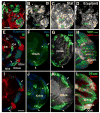Concomitant requirement for Notch and Jak/Stat signaling during neuro-epithelial differentiation in the Drosophila optic lobe
- PMID: 20692248
- PMCID: PMC3551593
- DOI: 10.1016/j.ydbio.2010.07.036
Concomitant requirement for Notch and Jak/Stat signaling during neuro-epithelial differentiation in the Drosophila optic lobe
Abstract
The optic lobe forms a prominent compartment of the Drosophila adult brain that processes visual input from the compound eye. Neurons of the optic lobe are produced during the larval period from two neuroepithelial layers called the outer and inner optic anlage (OOA, IOA). In the early larva, the optic anlagen grow as epithelia by symmetric cell division. Subsequently, neuroepithelial cells (NE) convert into neuroblasts (NB) in a tightly regulated spatio-temporal progression that starts at the edges of the epithelia and gradually move towards its centers. Neuroblasts divide at a much faster pace in an asymmetric mode, producing lineages of neurons that populate the different parts of the optic lobe. In this paper we have reconstructed the complex morphogenesis of the optic lobe during the larval period, and established a role for the Notch and Jak/Stat signaling pathways during the NE-NB conversion. After an early phase of complete overlap in the OOA, signaling activities sort out such that Jak/Stat is active in the lateral OOA which gives rise to the lamina, and Notch remains in the medial cells that form the medulla. During the third instar, a wave front of enhanced Notch activity progressing over the OOA from medial to lateral controls the gradual NE-NB conversion. Neuroepithelial cells at the medial edge of the OOA, shortly prior to becoming neuroblasts, express high levels of Delta, which activates the Notch pathway and thereby maintains the OOA in an epithelial state. Loss of Notch signaling, as well as Jak/Stat signaling, results in a premature NE-NB conversion of the OOA, which in turn has severe effects on optic lobe patterning. Our findings present the Drosophila optic lobe as a useful model to analyze the key signaling mechanisms controlling transitions of progenitor cells from symmetric (growth) to asymmetric (differentiative) divisions.
Copyright © 2010 Elsevier Inc. All rights reserved.
Figures







Similar articles
-
Drosophila optic lobe neuroblasts triggered by a wave of proneural gene expression that is negatively regulated by JAK/STAT.Development. 2008 Apr;135(8):1471-80. doi: 10.1242/dev.019117. Epub 2008 Mar 13. Development. 2008. PMID: 18339672
-
Role of JAK/STAT signaling in neuroepithelial stem cell maintenance and proliferation in the Drosophila optic lobe.Biochem Biophys Res Commun. 2011 Jul 15;410(4):714-20. doi: 10.1016/j.bbrc.2011.05.119. Epub 2011 May 27. Biochem Biophys Res Commun. 2011. PMID: 21651897
-
A Serrate-Notch-Canoe complex mediates essential interactions between glia and neuroepithelial cells during Drosophila optic lobe development.J Cell Sci. 2013 Nov 1;126(Pt 21):4873-84. doi: 10.1242/jcs.125617. Epub 2013 Aug 22. J Cell Sci. 2013. PMID: 23970418
-
Regulating the balance between symmetric and asymmetric stem cell division in the developing brain.Fly (Austin). 2011 Jul-Sep;5(3):237-41. doi: 10.4161/fly.5.3.15640. Epub 2011 Jul 1. Fly (Austin). 2011. PMID: 21502820 Review.
-
A challenge of numbers and diversity: neurogenesis in the Drosophila optic lobe.J Neurogenet. 2014 Sep-Dec;28(3-4):233-49. doi: 10.3109/01677063.2014.922558. Epub 2014 Jul 8. J Neurogenet. 2014. PMID: 24912777 Review.
Cited by
-
Cell-type-specific profiling of gene expression and chromatin binding without cell isolation: assaying RNA Pol II occupancy in neural stem cells.Dev Cell. 2013 Jul 15;26(1):101-12. doi: 10.1016/j.devcel.2013.05.020. Epub 2013 Jun 20. Dev Cell. 2013. PMID: 23792147 Free PMC article.
-
Drosophila ClC-a is required in glia of the stem cell niche for proper neurogenesis and wiring of neural circuits.Glia. 2019 Dec;67(12):2374-2398. doi: 10.1002/glia.23691. Epub 2019 Sep 3. Glia. 2019. PMID: 31479171 Free PMC article.
-
The proneural wave in the Drosophila optic lobe is driven by an excitable reaction-diffusion mechanism.Elife. 2019 Feb 22;8:e40919. doi: 10.7554/eLife.40919. Elife. 2019. PMID: 30794154 Free PMC article.
-
Tissue-wide coordination of epithelium-to-neural stem cell transition in the Drosophila optic lobe requires Neuralized.J Cell Biol. 2020 Nov 2;219(11):e202005035. doi: 10.1083/jcb.202005035. J Cell Biol. 2020. PMID: 32946560 Free PMC article.
-
Drosophila neuroblasts as a new model for the study of stem cell self-renewal and tumour formation.Biosci Rep. 2014 Jul 29;34(4):e00125. doi: 10.1042/BSR20140008. Biosci Rep. 2014. PMID: 24965943 Free PMC article. Review.
References
-
- Ashburner M. Drosophila, a laboratory manual. New York: Cold Springs Harbor Laboratory Press; 1989.
-
- Artavanis-Tsakonas S, Simpson P. Choosing a cell fate: a view from the Notch locus. Trends Genet. 1991;7:403–408. - PubMed
-
- Assa-Kunik E, Torres IL, Schejter ED, Johnston DS, Shilo BZ. Drosophila follicle cells are patternedby multiple levels of Notch signaling and antagonism between Notch and JAK/STAT pathways. Development. 2007;134:1161–1169. - PubMed
-
- Austin CP, Feldman DE, Ida JA, Jr, Cepko CL. Vertebrate retinal ganglion cells are selected from competent progenitors by the action of Notch. Development. 1995;121:3637–3650. - PubMed
-
- Bach EA, Ekas L, Ayala-Camargo A, Flaherty MS, Lee H, Perrimon N, Baeg GH. GFP reporters detect the activation of the Drosophila JAK/STAT pathway in vivo. Gene Expr Patterns. 2007;7:323–331. - PubMed
Publication types
MeSH terms
Substances
Grants and funding
LinkOut - more resources
Full Text Sources
Molecular Biology Databases

